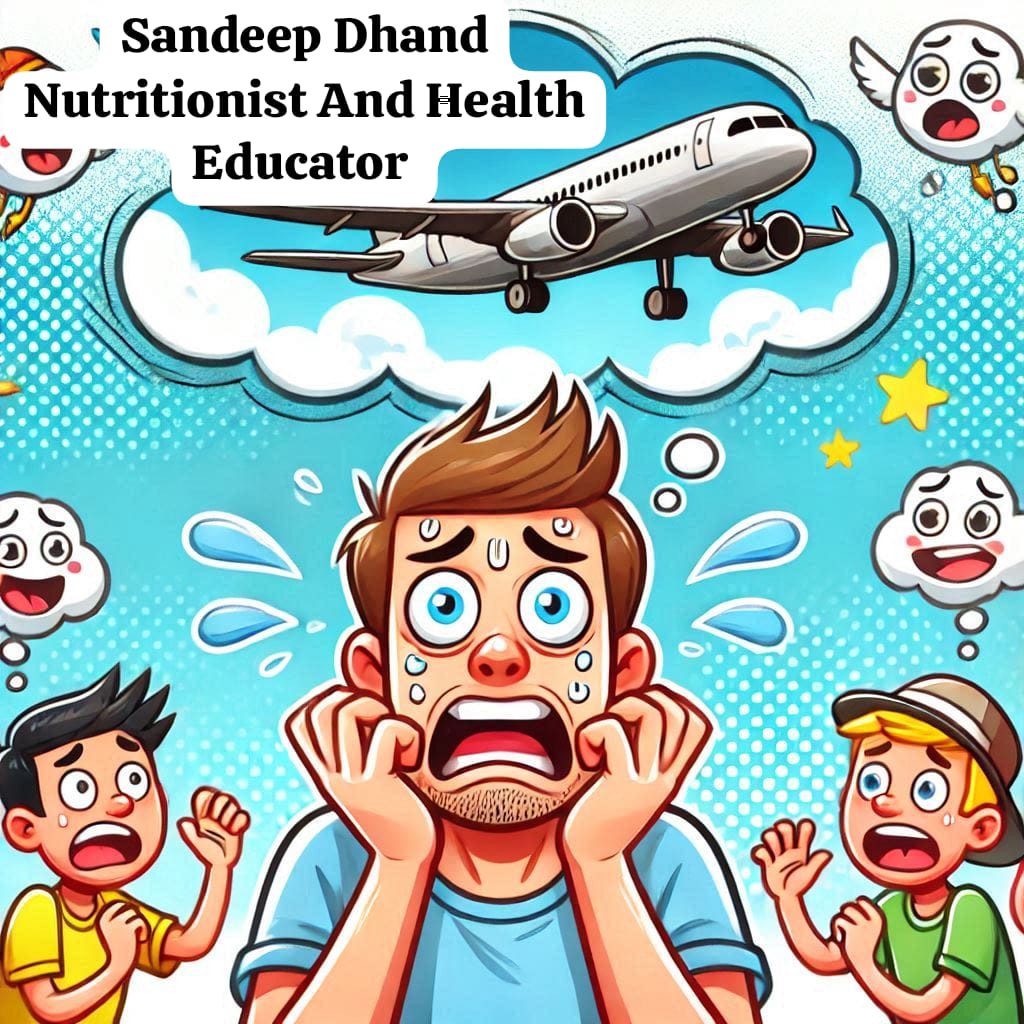Sandeep Dhand
Nutritionist And Health Educator
Aerophobia, also known as aviatophobia, is the fear of flying or being in an aircraft. It is a specific phobia that causes intense anxiety or panic when thinking about, preparing for, or experiencing air travel. This fear can significantly disrupt personal and professional life, especially for individuals who rely on air travel for work or family obligations. Aerophobia is more common than many realize, affecting millions of people worldwide.
Causes of Aerophobia

Aerophobia often arises from a combination of psychological, environmental, and personal factors. Key causes include:
- Traumatic Experiences: Individuals who have experienced or witnessed distressing incidents related to flying, such as severe turbulence or emergency landings, may develop a long-lasting fear.
- Fear of Heights (Acrophobia): A strong fear of heights can contribute to discomfort with flying, as it involves being at an extreme altitude.
- Claustrophobia: The confined space of an aircraft cabin can trigger feelings of being trapped or suffocated, exacerbating aerophobia.
- Loss of Control: Many individuals fear flying because it removes their sense of control, relying instead on pilots, crew, and technology for safety.
- Media Influence: Sensationalized news stories and movies about plane crashes can amplify fears by creating a perception that air travel is more dangerous than it actually is.
- Preexisting Anxiety Disorders: People with generalized anxiety or other phobias are more likely to develop aerophobia.
Symptoms of Aerophobia
The symptoms of aerophobia can range from mild anxiety to severe panic attacks and may include:
- Physical Symptoms: Sweating, trembling, rapid heartbeat, chest tightness, shortness of breath, nausea, dizziness, and headaches.
- Emotional Symptoms: Overwhelming fear, dread, or panic; irritability or mood swings before or during a flight.
- Behavioral Symptoms: Avoiding air travel at all costs, even when it leads to inconvenience or missed opportunities; procrastinating on booking flights or over-researching airline safety records.
Impact of Aerophobia
Aerophobia can have a profound effect on an individual’s life, restricting travel opportunities and leading to feelings of isolation or frustration. For professionals, it may hinder career growth if frequent travel is required. Personally, it can limit family visits, vacations, or the ability to explore new destinations. The emotional toll of the phobia often extends beyond travel, leading to feelings of embarrassment, inadequacy, or helplessness.
Treatment Options
Fortunately, aerophobia is a manageable condition. Various treatment methods have proven effective in helping individuals overcome their fear:
- Cognitive Behavioral Therapy (CBT): A widely used approach that helps individuals identify and reframe irrational thoughts about flying. CBT equips them with coping mechanisms to manage their anxiety.
- Exposure Therapy: Gradual exposure to flying-related situations, such as visiting airports or sitting in a stationary plane, helps desensitize the individual to their fear.
- Relaxation Techniques: Breathing exercises, meditation, and progressive muscle relaxation can reduce physical symptoms of anxiety.
- Education: Learning about the safety measures, technology, and mechanics of flying can demystify the experience and ease fear.
- Simulated Flight Experiences: Virtual reality or flight simulators allow individuals to practice being in a controlled, realistic environment without the pressure of an actual flight.
- Medications: Anti-anxiety medications or sedatives may provide short-term relief for those needing immediate help during a flight.
- Support Groups: Sharing experiences with others who have similar fears can offer emotional support and encouragement.
Prevention and Coping Strategies
While not all cases of aerophobia can be prevented, certain strategies can help reduce the risk of developing it or manage it effectively:
Practice Stress Management: Regular exercise, a healthy diet, and adequate sleep can reduce overall anxiety levels.
Limit Exposure to Negative Media: Avoid watching or reading exaggerated reports about air travel accidents.
Seek Early Help: Addressing fear at an early stage can prevent it from escalating into a debilitating phobia.
Use Distraction Techniques: Listening to music, watching movies, or reading during a flight can divert attention from fear.
Conclusion
Aerophobia is a challenging but treatable condition. Overcoming this fear not only enables individuals to regain the freedom to travel but also enhances their personal growth and opportunities. With appropriate support, therapy, and coping strategies, most people can conquer their fear of flying and enjoy the benefits of air travel. Recognizing the issue and seeking help is the first step toward reclaiming a life unrestricted by this phobia.
